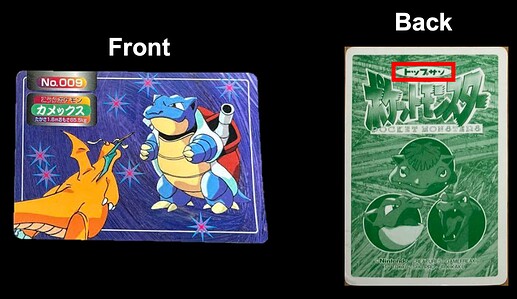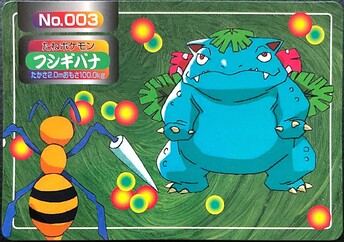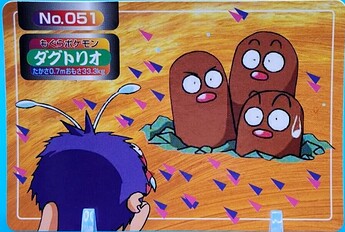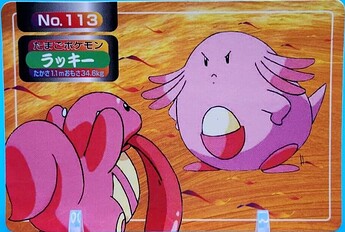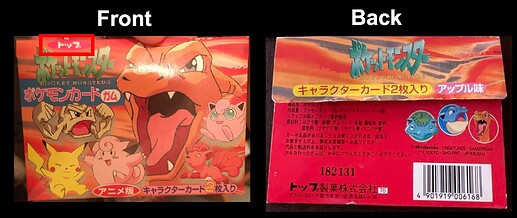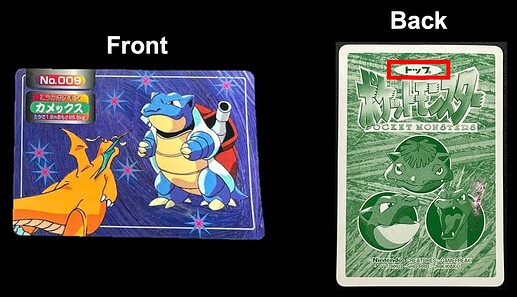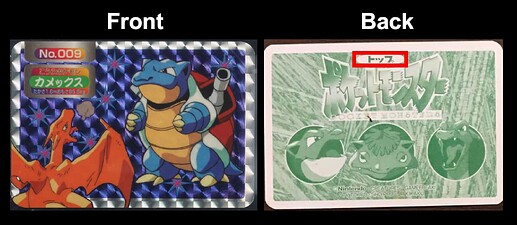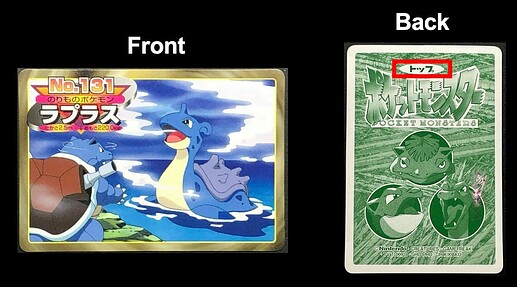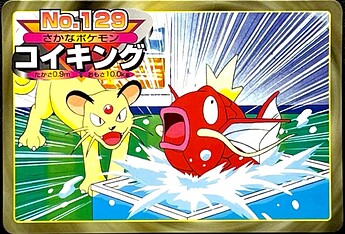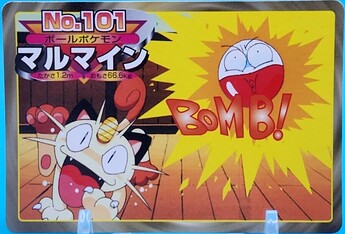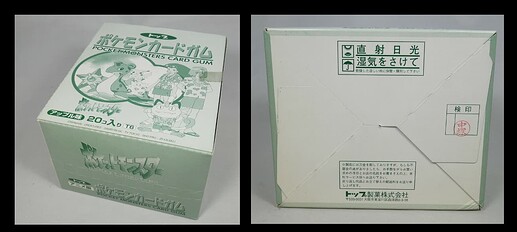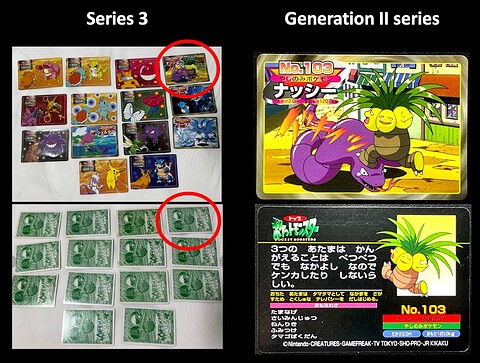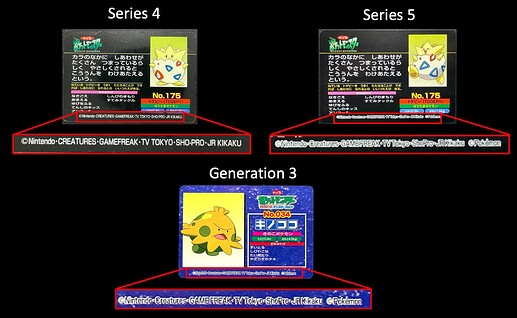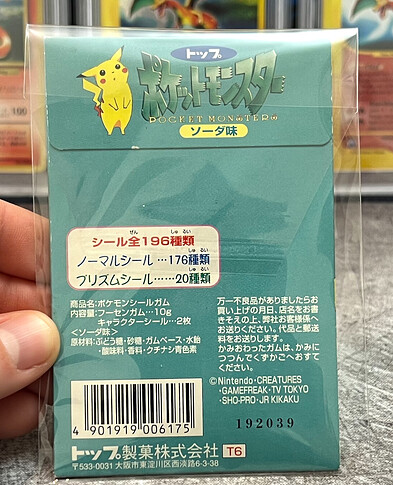Topsun/Top Battle Versus/VS Card Resource
Introduction
Welcome! I didn’t see any resources here for the Topsun/Top Battle Versus/VS sets, so I wanted to create this article to document, as best as possible, set lists and Pokemon appearances (for species collectors) for these cards. This article is currently a work in progress, as there are a lot of these sets with seemingly not that much information on them.
I’ve so far documented what I believe are mostly accurate set lists for the first three releases or “series” that cover all of the Generation I Pokemon. My sources for this information were Pokeboon’s article about Topsun cards, various threads existing on E4 (here, here, and here—big thanks to @cullers and @quuador for discussing some information about these sets before), and my own empirical data from scrutinizing listings on Mercari Japan. If you know of any incorrect information present in these lists or in the article, please let me know and I’d be happy to correct it.
Drafted set lists and Pokemon appearances for all series described below (so far) can be found here.
Additionally, a picture of every card for Series 1-5 can be found here.
With all that out of the way, let’s jump into it!
What are the Topsun/Top Battle Versus/VS Sets?
These aren’t your typical blue-back, green-back, no-number, first-Pokemon-cards-released (but not really) Topsun cards. These are your two-for-one Topsun bargains, as each card features, not one… but two Pokemon—locked in heated battle. There doesn’t seem to be an official name for these cards, but they are often referred to as “Topsun Versus/VS cards” or “Topsun Battle cards,” which is why I’ve tried to include all terminology in the naming of the set.
In the earlier series (i.e. Series 1 and 2, which will be elucidated below), the card design simply depicts two Pokemon standing opposed to each other, with one having its back facing you, reminiscent of in-game battles in the video games. But later versions (Series 3 and on) actually feature the Pokemon in action poses, using attacks that you might recognize from the games or anime. Contained within these Battle VS sets are some fan-favorite legendary matchups, like Blastoise vs Charizard, Rayquaza vs Groudon, and—everyone’s favorite—Seel vs Articuno.
I have seen these Battle VS sets cover up to Generation IV. I’m not sure if these sets exist for Generation V and beyond, but I may have just missed them for now.
Series 1 (Generation I)
Sources state that gum packs containing these cards were first released in 1997. Notably, these cards were distributed while Topsun was still utilizing the Topsun (トップサン) label. This label serves as a unique identifier of the Series 1 packs and cards, as Topsun changed their branding to Top (トップ) in all subsequent Battle VS set releases.
These cards feature two Generation I Pokemon posing on opposite ends of the card, with the putative “Attacking” Pokemon in the top right and the “Defending” Pokemon in the bottom left. In the top left corner, you’ll find some Pokedex information on the Attacking Pokemon: Pokemon type (e.g. Chansey, the “egg Pokemon”), name, height, and weight. In the absence of an official set list, I’ve designated each Pokemon’s Pokedex number as the card number, as each Pokemon only features as an attacker once. The Pokemon chosen to receive cards in the Series 1 release seem a bit random, but are generally focused in the earlier half of the Pokedex.
Each gum pack contains two of these cards, and in total, there are 52 cards to collect from this series.
Pictures of pack (note the “Topsun” label):
Pictures of example card (note the “Topsun” label):
The set also contains a few fun poses that bring a bit of charm and color into the somewhat plain design of the cards. Here are some of my favorites:
Possibly the only depiction of a bipedal Venusaur?
This Dugtrio concerned about having to face off with a menacing Venonat
Chansey giving you a stern look
Series 2 (Generation I)
As mentioned prior, from here on out, the packs and cards utilize the Top (トップ) label. This helps differentiate Series 1 and Series 2 cards, as the front is identical for those cards that are shared between the two series. However, it should be mentioned that, if you’re looking for these cards on online marketplaces, a majority of listings will still refer to these cards as “Topsun” cards despite the label change. Given this change, it’s not clear when the distribution year of this series was, as many refer to it (and Series 3) as 1997 Topsun cards, but in Pokeboon’s article about Topsun cards, it seems like the Top label might’ve been put into use in 1998. Thus, the year of set release is ambiguous.
Series 2 follows the same card layout as Series 1 and actually includes all of the Series 1 cards, but expands on the number of Attacking Pokemon featured, covering all Pokemon up to Seel. One major change, though, is the introduction of holo or prism foil cards. These foil cards feature the Attacking Pokemon opposing a different Pokemon than the regular card in the set.
The Series 2 set has 100 non-holo cards and 21 prism foil cards. Similar to Series 1, each gum pack contains two cards, with the chance of pulling a foil card being roughly 1 in 20 packs (quoting @cullers here).
Pictures of pack (note the “Top” label):
Pictures of example cards (note the “Top” label):
Original style:
Prism foil:
@cullers has a picture of an uncut sheet of prism foil cards here (from either Series 2 or 3).
Note: It is possible that not all 21 prism foil cards were released in this series, as there is no way of differentiating Series 2 and Series 3 cards (covered below).
Series 3 (Generation I)
For Series 3, the gum pack design changed. For some reason (which I do not know the answer to), these packs—but not the cards—are sometimes referred to as “Southern Island” packs, just in case you’re keen on searching for them.
Series 3 is interesting as it breaks away from the card layout used for Series 1 and 2 and introduces a gold-bordered “anime-like” versus card, with actual backgrounds and more dynamic posing. These “anime style” cards cover the remaining Pokemon that weren’t covered in Series 2 and are therefore focused on the latter half of the Pokedex (Dewgong and onwards). Additionally, these “anime style” cards become the norm for these Battle VS cards from here on out.
The backs of the Series 3 cards are the exact same as that of the Series 2 cards (this will be an important point touched on below). Given that Series 3 includes all of the Series 2 cards, the overlapped cards are seemingly indistinguishable, almost rendering the Series 2 release as obsolete.
Importantly, on the back of the pack, we finally have confirmation of how many cards are in the set! There are 150 “normal” set cards and 21 prism foil cards. These “normal” cards can be broken down into two different card designs (“original style” and “anime style”) and cover all Generation I Pokemon except Mew. Mew, instead, can be found as one of the prism foil cards. Thus, our Generation I Pokedex is complete! Each of these packs also comes with two cards, with the same 1 in 20 packs chance at a holo card (quoting @cullers again, here and here—I’m assuming the 1 in 40 he mentioned in the latter post is 1 holo per 40 cards, which is the same as 1 holo in 20 packs).
Pictures of pack:
Pictures of example “anime style” card (“original style” and prism foil cards are the same as Series 2):
One of my favorites is Magikarp performing the only attack it knows on a poor Persian:
Electrode’s face while exploding is also a good one:
This series is also the only series that I’ve found a pack opening for on Youtube, which can be found here.
I was able to find a picture of a case of these packs too, so I’ll include the picture here for sake of documentation. It looks like 20 of the packs are available in each case.
Lastly, as you can tell with the progression from Series 1 to Series 3, cards from previous series can be cannibalized into the newest series released. This is going to be seen again with the “anime style” cards in Series 3, as some (and possibly all) of these cards can be found in the Generation II Battle VS set(s), but with updated backs to reflect the change in card design (see below). Thus, only those with the plain green-back design are part of the earlier Series 3 release.
Series 4 (Generation II)
This series covers all of the generation II Pokemon (except Celebi) and features a new back side to the cards with additional information about the Attacking Pokemon. This series also appears to contain reprints of all of the generation I “anime style” cards in Series 3. The Series 3 and Series 4 cards can be easily differentiated by the reverse side of the card (see above). I can’t confirm that all the generation I cards were reprinted here, but I think it’s a reasonable guess. This series does feature one new generation I card, Mew, who was only available as a prism foil in Series 2 and 3.
Series 5 (Generation II)
This series features all new cards, a majority of them from generation I. Cards from this series can be differentiated from Series 4 cards due to a subtle change on the back of the card. Where the copyrights are at the bottom, you’ll see that the font style differs between Series 4 and Series 5, with the latter adopting a style that would later be used for generation III VS cards also (see below). From my own experience trawling through listings on Mercari Japan, I believe the Series 5 cards were relatively short printed or not as readily available/not as popular, as the cards from this series do not seem to show up as often as Series 4 cards.
The set list here is really just a best guess from me based on any existing cards I could find a picture of. It seems like the intent of this series was to return to generation I to fill in the gaps for Pokemon that were missing an “anime style” card while integrating generation II Pokemon in the set (as the Defending Pokemon), but many generation I Pokemon are still left lacking a card in this style. A few generation II cards were also released in this series. Most notable is Celebi, which was the only generation II Pokemon missing from Series 4. Additionally, for whatever reason, Cleffa and Togepi also received new cards, with different Defending Pokemon than in Series 4.
Andddd that concludes all I’ve put together for now! I don’t know when the next update will be. It seems like there is a dearth of information about set lists and distribution/release of these later sets. Given this, a lot of the set list data for the later series are likely going to be based purely on empirical data and might be incomplete.
Thanks for reading!

